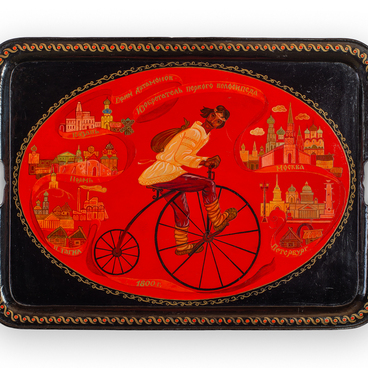The museum’s exhibition features a rectangular tray with a pierced rim attached by riveting and cast handles. In the center of the tray, there is a colorful scene enclosed in a golden rectangular frame. “The Departure of the Sons of Tipu Sultan from the Zenana” is a copy of the painting by the American and English artist Mather Brown.
Along the perimeter of the base, there is a wide border with a golden floral pattern made using a stencil. On one side, there is a brand that indicates that the product was crafted in the workshop of Yestifey Osipovich Golovanov. The tray was created by the brothers Sidor and Vasily Dubasnikov, 19th-century craftsmen from Nizhny Tagil.
The rectangular shape of the tray was achieved with the help of cold riveting. It was used during the 18th century and the first half of the 19th century. All the components of the tray, including the base, rim, and handles, were produced separately. The upper edge of the rim was adorned with a bead-shaped border, a typical decorative element of Nizhny Tagil trays.
The composition was inspired by 18th-century Indian history. Tipu Sultan was the Indian Muslim ruler of the Kingdom of Mysore from 1782 to 1799. He went down in history as the leader of the resistance against the British colonial forces. He is admired as a national hero in Pakistan and some Indian states. In alliance with France, he fought in the Anglo-Mysore Wars. His enemy was the British East India Company that attempted to assert its influence over South India. During the reign of his father, Tipu Sultan achieved significant victories over the British forces in the First and Second Anglo-Mysore Wars.
During the Third Anglo-Mysore War (1790–1792), British troops led by Lord Charles Cornwallis, Lieutenant-General of the British Army and the Governor-General of India, besieged Tipu Sultan in the fortress of Seringapatam, the island’s capital. Tipu Sultan was forced to sign a treaty, agreeing to cede most of the previously conquered territories to the British and pay a compensation of 33 million rupees. Before he fulfilled his obligations, his two young sons were held hostage. The artist depicted them leaving home. In March 1794, all the terms of the treaty were met, and the hostages were released and returned to their father.
Sidor and Vasily Dubasnikov were working not with the original painting, but with a smaller black-and-white engraving by Francesco Bartolozzi. They might have received the engraving from Nikolay Nikitich Demidov, a factory owner from Nizhny Tagil. To use this image in their artwork, the Dubasnikov brothers had to enlarge the engraving to the size of a tray and come up with an appropriate color palette.

